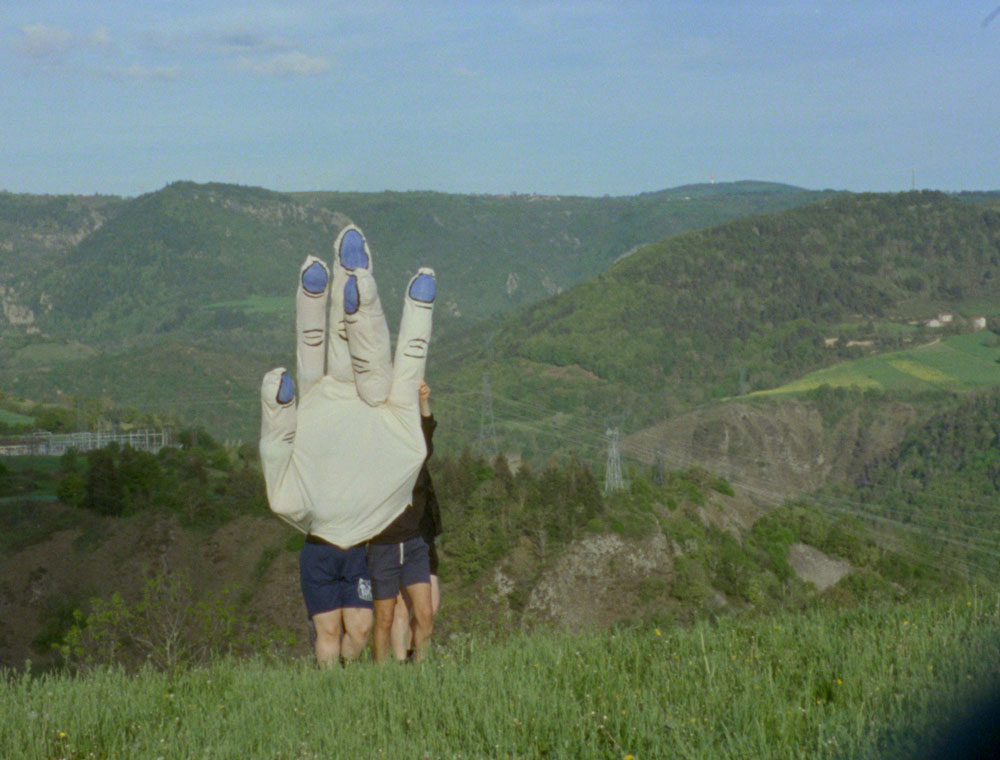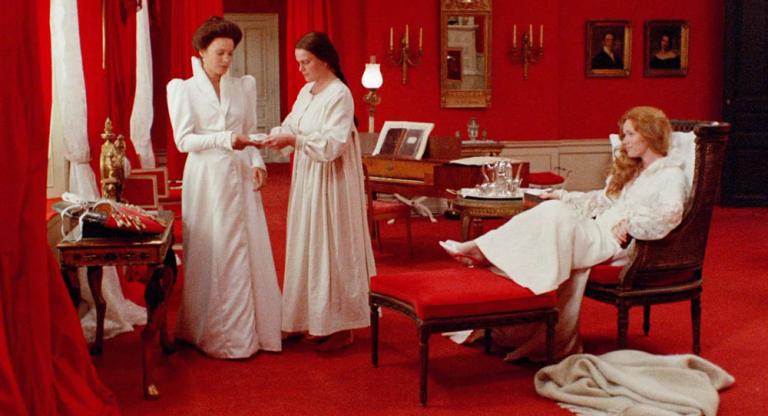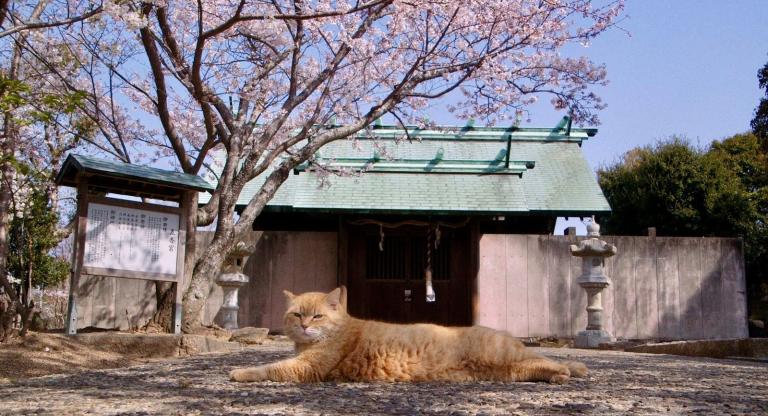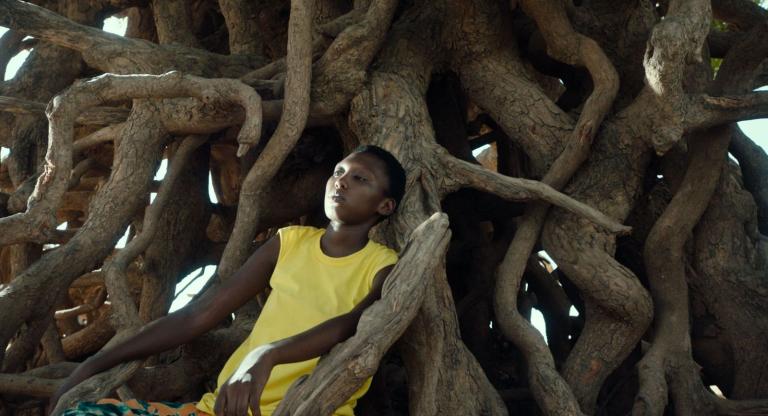Gelare Khoshgozaran’s work is informed by recognition through difference. The artist, who left their native Iran in 2009 and operates primarily out of Los Angeles, uses their documentary practice to rigorously consider their positionality as both an educator and refugee. Freely adapting texts from Jacques Lacan and the Talking Heads in their early work, Khoshgozaran established a serious yet formally playful ability to personalize the Iranian media theorist Hamid Naficy’s concept of accented cinema, which is “constituted both by the structures of feeling of the filmmakers themselves as displaced subjects and by the traditions of exilic and diasporic cultural productions that preceded them.”
In Khoshgozaran’s art, the voices of exiled authors like Roberto Bolaño, Edward Said, and Mohsen Makhmalbaf are afforded equal importance as less famous (and visible) subjects. In Medina Wasl: Connecting Town (2018), the words of veterans from the US-led campaigns in Iraq and Afghanistan are spoken by professional actors, complementing Khoshgozaran’s depiction of the eponymous site’s reconstruction. Khoshgozaran's dynamic depiction of recalled and repurposed sites asks how space can be cultivated beyond the historical specter of imperialist violence.
Their latest film, The Retreat (2023), expands on the dialectic between space and stories present in their previous work to include conversations with the multinational participants of The Exile Retreat—a retreat meant for collective reflection on the relation between mental health and the experience of exile or seeking asylum—in Monistrol d’Allier, France. Pairing footage of direct testimonies alongside more creative forms of therapy, Khoshogozaran and their collaborators produce a snapshot of collective care that’s resolutely radical in practice and intent. Ultimately, The Retreat encapsulates Khoshgozaran’s generative cinema of—per Angela Davis—freedom as a constant struggle.
Nick Kouhi: Your work has this tendency to intertwine historical archives, personal memories, and dreams. On that note, I’d like to start by asking about the earliest memory you recall, either of something you experienced or dreamt.
Gelare Khoshgozaran: I don't recall what I had seen, but my drawings from childhood are kind of my first proof of what I may have been seeing. There's a lot of palm trees and there's a lot of rivers and flags and tanks and helicopters and planes and cars. Given that I was mostly in central Iran, I didn't live by the border. So the war was not impacting us in the same way that it would, let's say, people who live in southern, southeastern Iran, or near any border town. I think those memories must have come from the media somehow. I think images of the war must have been one of the first ones for sure.
NK: What do you remember about the depiction of the Iran-Iraq War in state media, and how did you end up finding contradictions in what was being shown to you at a young age?
GK: I think just learning more and reflecting more on the power of media, and the fact that none of it is neutral. There's an agenda and it's one of the most powerful and influential modes of speaking by the state anywhere. Those specific kind of images, I think what they did was that from an early age, [they] made me skeptical about any kind of moving image and sound—mass media, propaganda for lack of a better word. But I honestly don't think that there's any public media that could be separated from this word propaganda. That's why I'm kind of trepidatious around using this specific word, in the sense that there is an agenda when there's public funding and ideology at play. It actually requires a [good] deal of media literacy to parse through what is being presented and what is actually some of the context that's surrounding these images that we're being exposed to.
NK: You were born in 1986, around the time Iranian Cinema was undergoing a new golden age. Were you creatively inspired by some of the films coming out during the 1990s, or did you seek inspiration from other filmmakers and artists elsewhere?
GK: Funnily, not so much in the ‘90s. But the years after, when I was in high school, my early inspirations were actually from world auteur cinema because I got to watch them on state TV. Every week there was a film scholar that would present a film by an auteur and that's when I got to know about the cinema of Tarkovsky, Kurosawa, Truffaut and Theo Angelopoulos. It was sort of a window into not just cinema from other parts of the world, but the world and what other people, other thinkers, have been responding to in relation to the context in which they were working.
The series was called Cinema 4, it was broadcast on Channel 4, which was dedicated to culture and science. One highlight in that series was The Death of a Bureaucrat [1966]. It was a dark comedy about the absurdity of bureaucracy under socialism in Cuba at that time. It was through film that I was given a window into a lot of places that I had heard about in geography lessons, or through news media—the world was being conjured without me having traveled there. It created a kind of curiosity about politics in other parts of the world—culture, history, gender dynamics, etcetera.
On the other hand, the cinema of Mohsen Makhmalbaf at the time was very jarring for me because I think he was doing weird things that I didn't see other people do. His films made me very uncomfortable. I was very young [when] my mom would take me to film festivals. I would sit in the theater and watch these very overwhelming, confusing films with a lot of violence. Not, like, gore kind of violence, but themes of violence and abandonment, and children and poverty. I was really shocked by them as a child. But then, as I grew up, I saw Salam Cinema [1995]. I think that's one of my favorite films of his, or the entire history of Iranian cinema. That is his utmost reflection on cinema itself and its production. I look back at that film a lot. I think it plays with the documentary form in a really interesting way, with a violent amount of manipulation. It’s not a straight documentary, but a really interesting portrait of the society that I was living in at the time in relation to the role of the media, specifically the medium of cinema and this desire to be represented, this desire to be part of the image.
To put it simply, I think cinema was like a way of thinking about world-making. I don't know, I don't want to say building, but kind of being in relation to a much larger world than the specific environment in which I was living and the specific society that I was a part of.
NK: Hearing you speak a little bit about world-building and a traversal of these different worlds reminded me of the María Lugones essay “Playfulness, ‘World’-Travelling, and Loving Perception”’ (1987) which you've cited as a major influence on The Retreat. When did you first read that piece?
GK: Not a while ago. A friend recommended her work to me a few years ago and then I [read it] four years ago. I think it was during the pandemic. Hers is a woman of color’s critique of the critique of travel as a neocolonial phenomenon. She was kind of flipping that on its head, questioning what we mean by travel and the necessity of visiting one another’s world, not as a luxury. Of course, there's a lot of problematics around [the] tourism industry and the voyeuristic aspect of going into communities as though they were wildlife, seeing different lifestyles, and all of that. But her take was completely radical in the sense that visiting one another's world doesn't really need to involve crossing a physical border, as much as listening and learning through playfulness. It’s a much more radical way of looking at world travel. I think cinema, along with literature, was a part of that world visiting for me, like it enabled visiting other people's worlds.
In a way, it was kind of [like these] fragments of a world that you're trying to put together, but through the narratives of the most eloquent writers and thinkers. And there was a privilege in that too. I'm very happy that I learned about Spain through Federico García Lorca as opposed to a touristic trip to Malaga. In a way, it was kind of like a curated experience of a window into a world. That's what cinema did for me and I really appreciated that. I sometimes look back and wonder what I would be like had it been a different situation, had I encountered the places and the filmmakers in a different way.
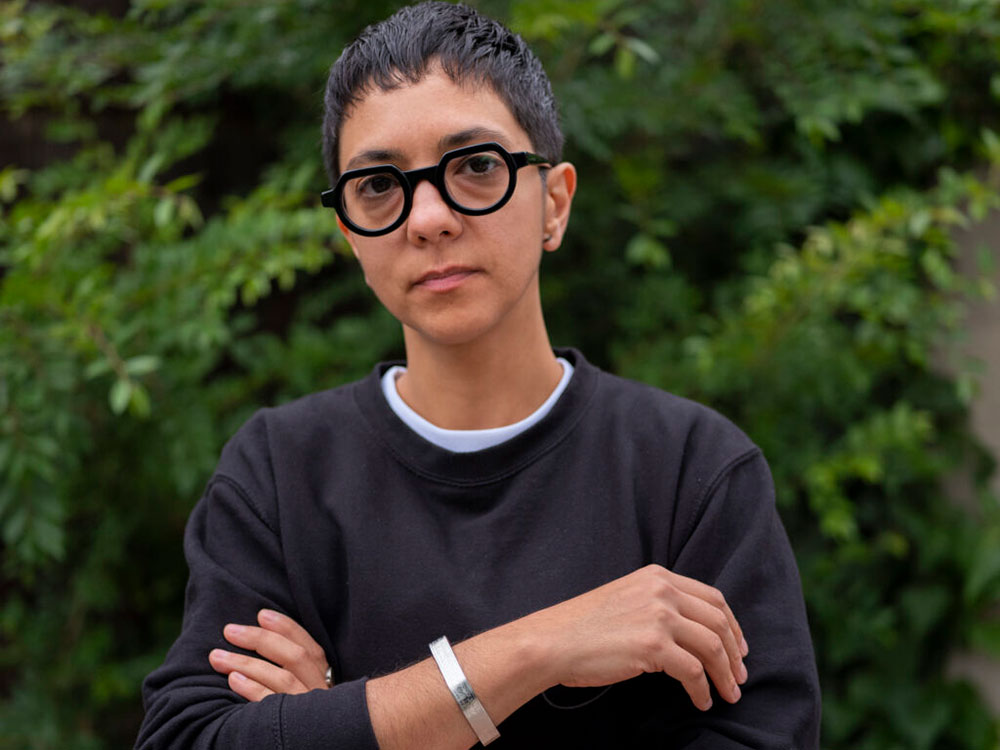
NK: Speaking of world literature, you quote Adolfo Bioy Casares’s The Invention of Morel in The Retreat. But you repurpose the text, which is a darkly romantic novella about image-making that’s fundamentally patriarchal, for a project whose approach toward image-making is comparatively more liberatory.
GK: I was blown away by it when I read it. It's such an interesting book on media, the preservation of images and memory, and definitely this romantic obsession with preserving the woman that you're falling for infinitely. And then, that woman kind of going from one lover to another as an image.
I was thinking about how to use the novella as a way of disorienting the viewer, and building anticipation in terms of what kind of story are we about to see or what's going to happen? So I thought about it as an introduction into The Retreat and using it over the footage of the Pacific Ocean.
I was kind of thinking of playing with this tired stereotype of the refugee who arrives on a boat and looking at the ocean from a rocking boat. One of the main concerns that I had with the work was the way in which the figure of the refugee is like this generalized boogeyman—it’s always talked about in the context of a crisis, in the context of the economy, in the context of the job market. But it's never centralized as the producer of knowledge. Like, what does that vantage point of being on the run from the world’s multiple violences give those who don't have that experience as a way of learning about the world that we inhabit? That's kind of why I wanted to use the view of the ocean from the boat. Although, obviously, if you're on a boat fleeing violence, it's not as serene—as I had it on a boat here in the Pacific Ocean. For me, the words of the fugitive from The Invention of Morel poignantly spoke to that vantage point of being on the run and arriving at an abandoned island.
There was a lot of irony in that too that felt very contemporary—that a group of white people arrived on this island and built a resort, and then they abandoned it. There was [a] kind of humor in that too. And then, having my friend read the voiceover from a clearly female voice was a way of not perpetuating the same kind of gender dynamics of the situation, but being playful with it, and using the text’s brilliance, but also challenging it and playing with it too.
NK: You draw upon such an extensive range of literary inspirations, but your interest in the participants you collaborate with, particularly political refugees, exudes a strong respect for their safety. To that end, how have you subsumed your artistic inspirations while allowing space and safety for others to take part in telling their story?
GK: It's more about really processing, digesting, and analyzing the reasons for those inspirations, taking the parts that I can take away with me, using them, and applying them in my ways, but leaving some parts behind, or trying to rework them to different degrees of failure and success. I'm not saying that my method of excluding faces, for example, is necessarily resolved. But I was interested in going against the grain of so much representation. Especially in recent years, a lot of figuration has come to the surface again across the arts, both in cinema, but also painting and photography. Even thinking in terms of machine learning and the databases that are being created out of images, I've been questioning the use of, or the presentation of faces. Again, it doesn't mean that I'm not going to ever do that. I might change direction with the next project, but with The Retreat specifically, I was thinking of being very intentional about that.
That was communicated in advance to the participants, that if their hand or other body parts enter the frame, I would use it, but there's not going to be any kind of sitting in front of a camera and narrating your story, or anything like that. I think that established a bit more comfort and a bit more of a trust, I hope.
When it came to the selection of the people, I didn't need to think about what the selection of people looked like as a few faces that represented different regions, languages, cultures, genders, or body types. I was lucky enough to be with a group of people [where] some were more vocal, some were less vocal. Some were more interested in singing and some were really into talking and processing. I think that allowed for other possibilities, for people to be present but with ways, and in ways, that they both felt compelled to.
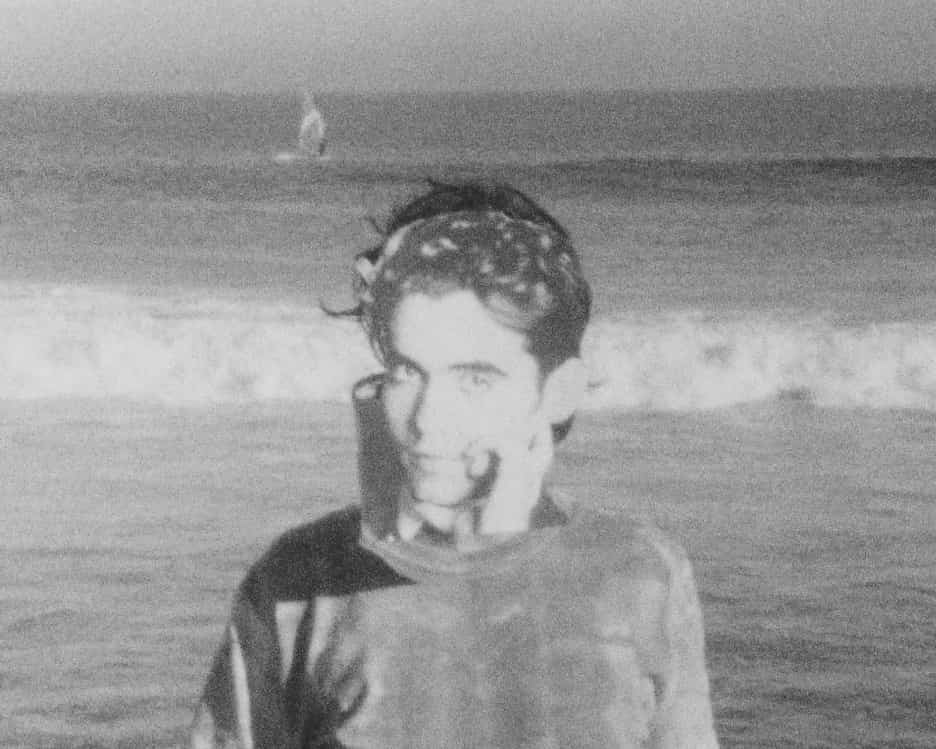
NK: Another thread that winds its way through several of your films is this aspect of play or performance. I'm thinking specifically about Men of My Dreams [2023], where you have these masks of men who inspired you that you're holding over your face, but then you have a little bit of that too in The Retreat with these costumes that are constructed.
GK: With Men of My Dreams, it was more [of] a DIY project in the pandemic. I'm going to be the only one who's going to be in front of the camera because I don't have any other options. But because it's about dream encounters and my relationship to these people, it would be my body and [I] cheaply, quickly made masks of them. It kind of made sense in that way.
When it came to The Retreat, the research was very tied to the Saint-Alban hospital and the legacy of Francesc Tosquelles, and thinking about Ergotherapy, as they used to call it at the time, and art therapy in general. I was reading a lot on play, play therapy, and narrative therapy. I really thought it would be good for us, as a group, to have some kind of activity that we could do together that would be outside of sitting around the table and having a formal conversation. Together, we also navigated the failures and the limitations of what we had access to: the limited number fabric pieces that we had, the hardware, or there only being one sewing machine, and one person with any kind of skills—but how could we kind of sous-chef her, be her assistant, and make things happen?
That sewing machine and the desk became the therapy chair. It worked as a stand-in for a lot of interactions. It was also like you're visiting your friend who is doing something with their hands and you have a chat with them. The props were not the end itself, but their making was an excuse to alter the space. One of the participants said, “I want a hand.” So everyone came together and we made a hand that required five people to carry it. It was not possible for [only one person] to wear the hand, so all of us came together and held the hand together.
NK: I'm reminded of the abolitionist writer Mariame Kaba and her description of collectivizing care. In the context of what you're doing, there is something consonant with an abolitionist philosophy that's rooted in supporting other members of your community as a way of posing alternatives to what Lugones called “agonistic” modes of thinking. And Tosquelles was himself an abolitionist, if I recall correctly.
GK: It's interesting that you brought this up because Mariame Kaba has been one of the people that I've learned a lot from just from reading her and listening to her. And someone whom I consider a big inspiration and very generous in the way that she disseminates information for free. I've been lucky to learn a lot from what she's put out there. Just to note, Tosquelles was really not an abolitionist. He was a reformist, funnily enough. As radical as he was, he was not anti-psychiatry. He didn't really believe in closing down the asylum. He was more like, “Let's take over this institution and see how else we can run it.” Which in our contemporary times is a neoliberal cliche. And this space of the asylum, instead of it being a space of oppression, pain, manipulation, and control, how can we turn it into an actual shelter? That was my dilemma with this project as an abolitionist myself. What is there to take away from this kind of utopian singular, seemingly successful project? How can we learn from it as abolitionists? What does that mean to me and our conversation these days around abolition?
I think the people that I was in conversation with had that position. It was interesting to have the conversation with them there, that this was the kind of reform that [Tosquelles] was advocating for and he practiced. How do we think about this? I was interested in thinking about [how] with any abolition there's a crucial transitional period of trial and error, and trying, and repurposing these institutions. What does that period of care look like? And once these places are shut down, once the prisons are closed, then what does care look like for those who were formerly incarcerated or impacted by the carceral system? None of these timelines are linear and these periods, acute. It’s not like one act begins at the end of the other: care is ongoing work.
NK: You will be presenting The Retreat at MoMA, which marks your first appearance in New York. The city is very much a transitional place where many refugees and immigrants have come to America, yet it also remains one of the most highly surveilled cities in the country. This is of course symptomatic of a larger issue concerning the roles institutions play in regulating human bodies, artists included, rather than fostering transnational solidarity. As someone who has worked with art institutions, how do you navigate that ecosystem while simultaneously working to cultivate alternative spaces beyond a punitive gaze?
GK: It's very difficult. I feel like the way that system that you mentioned continues to train us is based on fear and scarcity, but mainly on fear that if you lose an opportunity, then you know that's gonna lead to losing another opportunity. Whereas, if you get one and then ride that momentum—I hate that word—then you're gonna get more and more opportunities. Yes, there is a ring of truth to that. But, in my experience, working with shared principles is also a way of community building. I mean it truly in the sense that you would attract the kind of people who know you and want to get close to you because of who you are. It's kind of like friendship. So when it comes to professional relationships as well, you’ll mostly be working with people who you don't need to be so compromising with.
Yes, there [are] limitations within institutions and nothing is black-and-white. I guess the people that I look up to have taught me that there's a degree of risk that you can take that actually allows for you to be in places that you want to be, and in conversation with people that you want to be, as opposed to taking whatever comes your way.
Because [of] the way that these models work, I think of them as a way of ownership. A lot of the backlash that we've seen over artists taking a stance on Palestine has been these threats of collectors saying, “I'm going to deaccession your work.” The threats work as if they own the artist. They own their work. They own their thoughts. That to me is really depressing. I can't see myself working in that way. I’d much rather think about other ways of being able to sustain myself. Of course, nobody wants to be broke and stressed all the time. At some point, with age, you do want to have at least some sort of stability. But I think it's a lot more complicated than the one solution that they put in front of you, which is often complacency.
Going back to the question of Iran, I guess I do take a lot of those experiences to heart. What are the reasons for me not staying there and being here? And what does that mean to me? What does liberty really look like to me? When I say freedom, what do I mean by it? And do I mean it just for myself or the other people that I love and care for? Today, somebody reminded me of this quote by Toni Morrison that I’ve been sitting with all these years. I tell my students, "When you get these jobs that you have been so brilliantly trained for, just remember that your real job is that if you are free, you need to free somebody else. If you have some power, then your job is to empower somebody else. This is not just a grab-bag candy game.”
“An Evening with Gelare Khoshgozaran” takes place tonight, March 4, at the Museum of Modern Art as part of Doc Fortnight. Director Gelare Khoshgozaran will be in attendance for a Q&A.
